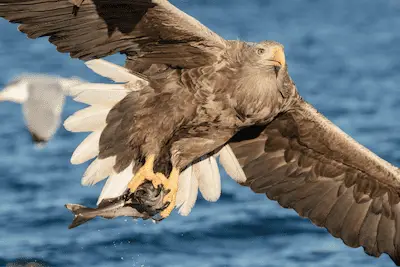White-tailed Eagle
(Haliaeetus albicilla)
Another name for the White-tailed Eagle is Eurasian Sea Eagle, which can be attributed to the fact that the sea coast (or large lakes) are its preferred habitat.

However, White-tailed Eagles are also found far away from the sea, and can breed in areas with little water as long as they have a plentiful food source.
White-tailed Eagles are opportunistic raptors that feed on many different animals, and tend to take advantage of whatever species are most common (or easiest to catch), and are also partial to carrion.
After a catastrophic decline of White-tailed Eagles last century, the species has made an astonishing comeback in many parts of Europe, and even started recolonizing areas where it was extinct.
White-tailed Eagle facts
White-tailed Eagles are very large raptors that are unmistakable when you have the fortune to spot one in the field.
White tailed Eagle size
With a wingspan of almost 2.5 meters, the White-tailed Eagle is the largest European eagle species.
- Wingspan: 200-245 cm
- Length: 78-95 cm
- Weight: 5,200-6,900 g (female), 4,100-4,600 g (male)
The only European raptors bigger than the White-tailed eagle are the Cinereous Vulture (Aegypius monachus), European Griffon Vulture (Gyps fulvus), and the Bearded Vulture (Gypaetus barbatus).
Appearance
The overall appearance of the White-tailed Eagle is that of a very large raptor with long, broad wings, a short, wedge-shaped tail, and a huge yellow beak.

Sexual dimorphism
Similar to many other raptors present in Europe, female White-tailed Eagles are significantly larger than males, to the extent that they don’t overlap in size at all. However, even male White-tailed Eagles are very large raptors, and bigger than other types of eagles in Europe.
Lifespan
A maximum age of 50 years has been recorded in captivity, as well as 36 years in the wild.
Scientific name and taxonomy
The scientific name of the White-tailed Eagle is Haliaeetus albicilla. While no subspecies is known, the White-tailed Eagle is closely related to the American Bald Eagle (Haliaeetus leucocephalus), and some scientists place them together in a superspecies.
White tailed Eagle distribution
The White-tailed Eagle has a large, but patchy distribution in Europe, with the largest populations found in Scandinavia and the European part of Russia. It is also found in Greenland and Iceland, as well as small populations in several countries of central and eastern Europe.
The overall European population of the White tailed Eagle has significantly increased over recent years, and as a result, it has started recolonizing some countries in which it was previously extinct, including Austria and the Netherlands.
A successful reintroduction program has also brought the White-tailed Eagle back to Scotland, where it now breeds with a small population. Outside of Europe, its range extends eastwards all the way to the Pacific Ocean and Japan.
White-tailed Eagle habitat
The White-tailed Eagle prefers habitat close to large bodies of water, either sea coast or large inland lakes or rivers. Sometimes it also occurs far away from water, if there is a plentiful food supply in that area. In addition to water, it also requires forests for nesting.
White-tailed Eagle population size
The European population of the White-tailed Eagle is estimated to be between 5,000 and 6,600 breeding pairs by BirdLife International. The largest populations are found in Norway (with up to 2,300 pairs), the European part of Russia (up to 2,000 pairs), and Poland (up to 700 pairs). The overall population trend has been increasing in many areas, so these numbers could be underestimated.
White-tailed Eagle behavior
White-tailed Eagles are most often observed foraging along the shore of the sea or inland lakes. They hunt from a perch, or by flying slowly at medium height over the water, until they spot suitable prey and swoop down to grab it.
Feeding and diet
The most important food source of White-tailed Eagles are fish, which can be taken either dead or alive, but always at the surface of the water. This distinguishes it from the Osprey (Pandion haliaetus), which dives fully into the water in order to catch fish.
After fish, the White-tailed Eagle also takes a lot of waterfowl, including ducks, coots, geese, and herons. Outside of the breeding season, it also takes a lot of carrion.
Overall, it should be noted that the White-tailed Eagle is an opportunistic raptor, and feeds on many different species, depending on what’s most readily available.
Breeding
The White-tailed Eagle builds a large stick nest in old trees or in cliffs. The nest grows in size over time, as a pair reuses the same nest again and again every year. The female lays 1-3 eggs, which are incubated for up to 38 days.
After hatching, the young eagles stay in the nest for up to 90 days. Cainism is not as common as with other large birds of prey species, and 2 chick are raised successfully in up to 50% of the cases.
White-tailed Eagle migration
The White-tailed Eagle is a partial migrant, with northern and eastern populations being largely migratory, while central European populations are sedentary. During the winter months, the White tailed Eagle can be observed in areas where it doesn’t breed, including southern Europe. However, most individuals from northern European populations winter in central Europe.
White-tailed Eagle conservation status
The White tailed Eagle underwent a massive population decline during the last century, mostly due to the use of the pesticide DDT, as well as direct persecution by humans. Since the use of DDT has been stopped, and persecution reduced significantly in most European countries, the White-tailed Eagle has made an amazing comeback, with some populations increasing by several hundred percent over the past decades.
Due to its large distribution range, and stable population size, the conservation status of the White-tailed Eagle is classified as “Least Concern” by BirdLife International. However, it’s important to note that there are still many threats to this magnificent eagle, and the populations could be considerably larger if we find a way to stop these.
Threats
The biggest threat to White-tailed Eagles is accidental death caused by humans, which can have a wide variety of causes, but includes lead poisoning (from buck shot), electrocution on power lines or pylons, and collision with cars and trains (which often happens when the White-tailed Eagle feeds on carrion).
